Parthian Empire
The Parthian or Arsacid Empire was the most enduring of the empires of the ancient Near East. After the Parni nomads had settled in Parthia and had built a small independent kingdom, they rose to power under king Mithradates the Great (r.171-138). The Parthian Empire occupied all of modern Iran, Iraq and Armenia, parts of Turkey, Georgia, Azerbaijan, Turkmenistan, Afghanistan, and Tajikistan, and - for brief periods - territories in Pakistan, Syria, Lebanon, Israel, and Palestine. The end of this loosely organized empire came in 224, when the last Arsacid king was defeated by one of his vassals, the Persians of the Sasanian dynasty.
Conquest
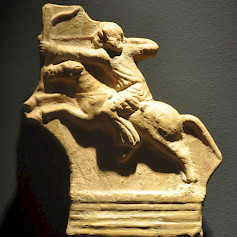
After the fall of the Achaemenid Empire, Parthia, northeastern Iran, was governed by the Seleucid kings: a Macedonian dynasty that ruled in the Asian territories of the former Persian Empire. In 245, when the Seleucids were involved in the Laodicean War in the West, a satrap named Andragoras revolted from the young Seleucid king Seleucus II Callinicus, who had just succeeded to the throne. In the confusion, Parthia was overrun by the Parni, a nomad tribe from the Central-Asian steppe.
In 238, they added the district known as Astavene to their possessions. Three years later, a Parnian leader named Tiridates ventured further south and seized the rest of Parthia. A counter-offensive by king Seleucus ended in disaster, and Hyrcania was also subdued by the Parni. The first king of the Parthians (as the Parni were called from now on) was Tiridates' brother Arsaces I. His capital was Hecatompylos.
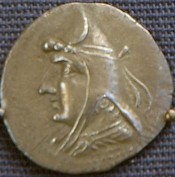
The kings of the Arsacid dynasty - Arsaces I, Arsaces II, Phriapatius, Phraates I - recognized the Seleucid king as their superior, especially after the campaign of Antiochus III the Great, who reconquered the lost eastern territories between 209 and 204. Although the Arsacids had to pay tribute to Antiochus, they were recognized as the lawful rulers in Parthia.
After 188, when Antiochus had died, a new phase of Parthian expansion started. King Mithradates I the Great (r.165-132 BCE) first attacked the eastern kingdom of Bactria. Having covered his rear, he moved to the west, where he conquered Media, one of the most important parts of the Seleucid Empire. Now, Babylonia lay almost unguarded. In July 141 Mithradates captured the Seleucid capital Seleucia, and in October he reached Uruk in the south of Babylonia. His Seleucid enemy Demetrius II Nicator tried to reconquer his lost territories, but was defeated and - even more humiliating - caught. Two years later, Elam was added to the Parthian empire.
Government
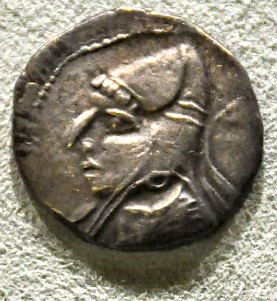
After the conquest of Media, Babylonia and Elam, the Parthians had to organize their empire. The elite of these countries was Greek, and the new rulers had to adapt to their customs if they wanted their rule to last. So the cities retained their ancient rights and the civil administration remained more or less undisturbed. An interesting detail is coinage: legends were written in the Greek alphabet, and this practice was continued in the second century CE, when knowledge of this language was in decline and nobody knew how to read or write Greek characters.
Another source of inspiration was the Achaemenid dynasty that had once ruled Iran. Courtiers spoke Persian and used the Pahlavi script; the royal court traveled from capital to capital; and the Arsacid kings wanted to be called - as Cyrus the Great had ordered his subjects to do in the sixth century - "king of kings". This was a very apt title. The Parthian monarch was the ruler of his own empire plus some eighteen vassal kings, such as the rulers of the city state Hatra, the port Charax, and the ancient kingdom of Armenia.
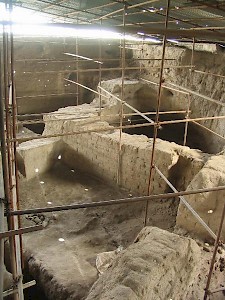
The Parthian Empire was not very centralized. There were several languages, several nations, and several economic systems. The loose ties between the separate parts, however, were the keys to its survival. In the second century CE, the most important capital Ctesiphon was captured no less than three times by the Romans (in 116, 165 and 198), but the empire survived, because there were other centers.
On the other hand, the fact that the empire was a mere conglomerate of kingdoms, provinces, marks, and city states could at times seriously weaken the Parthian state. This explains why the Parthian expansion came to an end after the conquest of Mesopotamia and Iran.
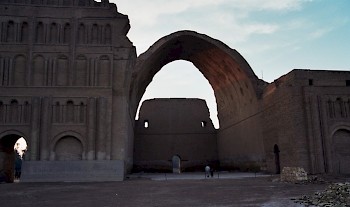
Local potentates played an important role and the king had to respect their privileges. Several noble families had a vote in the Royal council; the Sûrên clan had the right to crown the Parthian king; and every aristocrat was allowed/expected to retain an army of his own. When the throne was occupied by a weak ruler, divisions among the nobility could become dangerous.

The constituent parts of the empire were surprisingly independent. For example, they were allowed to strike their own coins. As long as the local elite paid tribute, the Parthian kings did not interfere. The system worked very well: towns like Ctesiphon, Seleucia, Ecbatana, Rhagae, Hecatompylos, Nisa, and Susa flourished.
Tribute was one source of royal income; another was toll. Parthia controlled the Silk Road, the route from the Mediterranean sea to China.
The western wars
The Seleucid Empire was assaulted from two sides: the Parthians attacked from the east, the Romans from the west. In 69 BCE, the two enemies concluded a treaty: the Euphrates would be the border. Six years later, the Roman commander Pompey the Great conquered what was left of the empire of the Seleucids.

In 53 BCE, the Roman general Crassus invaded Parthia. At Harran or Carrhae, however, he was defeated by a Parthian commander who is called Surena in the Greek and Latin sources, and must have been a member of the Sûrên clan. This was the beginning of a series of wars that were to last for almost three centuries.
The Parthian armies consisted of two types of cavalry: the heavy-armed and armoured cataphracts and light brigades of mounted archers. To the Romans, who relied on heavy infantry, the Parthians were hard to defeat. On the other hand, the Parthians could never occupy conquered countries; they were unskilled in siege warfare. This explains why the Roman-Parthian wars lasted so long.
In the years after their defeat, the Romans were divided between the adherents of Pompey and those of Julius Caesar, and because of the civil war, there was no opportunity to punish the Parthians. Although Caesar was victorious in this conflict, he was murdered, and a new civil war broke out. The Roman general Quintus Labienus, who had supported the murderers and feared Caesar's heirsMark Antony and Octavian, sided with the Parthians and turned out to be the best general of king Pacorus I. In 41, the Parthians invaded Syria, Cilicia, and Caria and attacked Phrygia and Asia. A second army intervened in Judaea and captured its high priest Hyrcanus II. The spoils were immense, and put to good use: king Phraates IV invested them in Ctesiphon, a new capital on the Tigris.
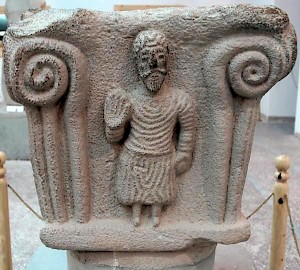
In 39, Mark Antony was ready to retaliate. Pacorus and Labienus were killed in action, and the Euphrates was again the border between the two nations. The Parthians had learned that they could not occupy enemy territories without infantry. However, Mark Antony wanted to avenge the death of Crassus and invaded Mesopotamia in 36 with the legion VI Ferrata and other, unidentified units. He had cavalry with him, but it turned out to be unreliable, and the Romans were happy to reach Armenia, having suffered great losses.
This meant the end of the first round of wars. The Romans were again fighting a civil war, and when Octavian had defeated Mark Antony, he ignored the Parthians. He was more interested in the west. His son-in-law and future successor Tiberius negotiated a peace treaty with Phraates (20 BCE).
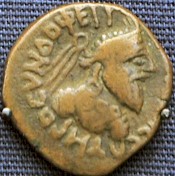
At the same time, the beginning of our era, the Parthians became interested in the valley of the Indus, where they started to take over the petty kingdoms of Gandara. One of the Parthian leaders was named Gondophares, king of Taxila; according to Christian tradition, he was baptized by the apostle Thomas. The story is not impossible: adherents of several religions lived together in Gandara and the Punjab, and there may have been an audience for a representative of a new Jewish sect.
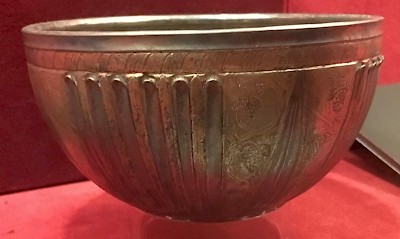
The Roman-Parthian war broke out again in the sixties of the first century CE. Armenia had become a Roman vassal kingdom, but the Parthian king Vologases I appointed a new Armenian ruler, Tiridates. This was too much for the Romans, and their commander Gnaeus Domitius Corbulo invaded Armenia. The result was that the Armenian king received his crown again in Rome from the emperor Nero. A compromise was worked out between the two empires: in the future, the king of Armenia was to be a Parthian prince, but needed approval from the Romans.
Decline
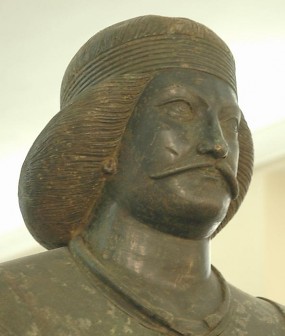
The Armenian compromise served its purpose, but nothing was arranged for the deposition of a king. After 110, the Parthian king Osroes I was forced to dethrone an Armenian leader, and the Roman emperor Trajan decided to invade Parthia. War broke out in 114 and the Parthians were severely beaten. The Romans conquered Armenia, and in the following year, Trajan marched to the south, where the Parthians were forced to evacuate their strongholds. In 116, Trajan captured Ctesiphon, and established new provinces in Assyria and Babylonia.
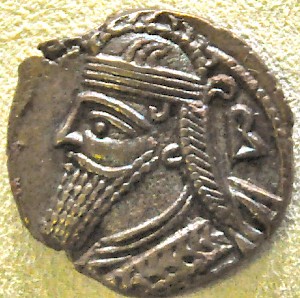
However, rebellions broke out (which proves the loyalty of the population to the Parthians). At the same time, the diasporic Jews revolted and Trajan was forced to send an army to suppress them (more). Trajan overcame these troubles, but his successor Hadrian gave up the territories (117). Nonetheless, it was clear that the Romans had learned how to beat the Parthians.
Perhaps it was not Roman strength, but Parthian weakness that caused the disaster. In the first century, the Parthian nobility had become more powerful, because the kings had given them more right over the peasants and their land. They were now in a position to resist their king. At the same time, the Arsacid family had become divided.
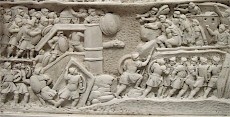
But the end was not near, yet. In 161 king Vologases IV declared war against the Romans and conquered Armenia. The counter-offensive was slow, but in 165, Ctesiphon fell. The Roman emperors Lucius Verus and Marcus Aurelius added Mesopotamia to their realms, but were unable to demilitarize the region between the Euphrates and Tigris. It remained an expensive burden. But it was now clear that the Romans were superior.
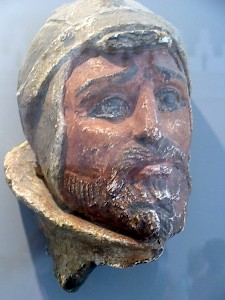
The final blow came thirty years later. King Vologases V had tried to reconquer Mesopotamia during a Roman civil war (193), but when general Septimius Severus was master of the empire, he attacked Parthia. Again, Ctesiphon was captured (198), and large spoils were brought to Rome. According to a modern estimate, the gold and silver were sufficient to postpone a European economic crisis for three or four decades, and we can imagine the consequences for Parthia.
Parthia, now impoverished and without any hope to recover the lost territories, was demoralized. The kings had to do more concessions to the nobility, and the vassal kings sometimes refused to obey. In 224, the Persian vassal king Ardašir revolted against the Parthian king Artabanus IV. Two years later, he took Ctesiphon (which may have been held by Artabanus' rival Vologases VI), and this time, it meant the end of Parthia. It also meant the beginning of the second Persian empire, ruled by the Sasanian kings.